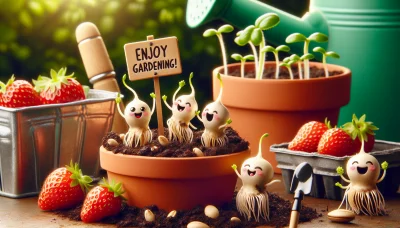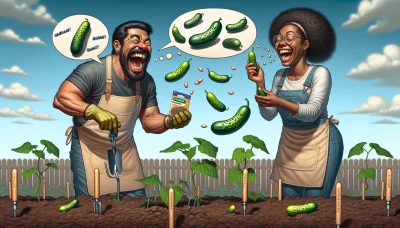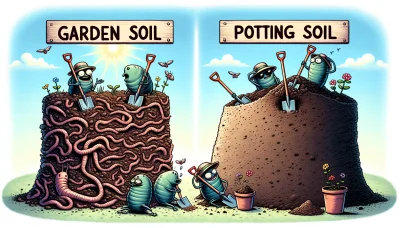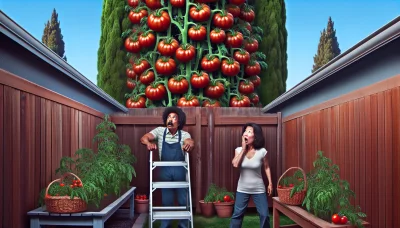How to grow the best tomatoes Quiz
Test Your Knowledge
Question of
How to Grow the Best Tomatoes
Growing tomatoes presents an exciting blend of challenges and joys that any gardening enthusiast can appreciate. There's something truly satisfying about nurturing your tomato plants from tiny seeds to robust vines laden with juicy fruits. The process, while sometimes demanding, rewards patience and care with the unparalleled taste of home-grown tomatoes. Whether you're aiming for the sweetest cherry tomatoes or the most succulent beefsteaks, the journey to cultivating the best tomatoes in your own garden is a fulfilling endeavor that brings a sense of accomplishment with every harvest.
Choosing the Right Tomato Varieties
When it comes to gardening, selecting the right types of tomato plants is crucial for both yield and taste. The choice of tomato variety can greatly impact your gardening success, as different varieties thrive under different climate conditions and offer varying flavors and uses. Whether you're looking for tomatoes to slice, dice, cook, or can, understanding the specific needs and characteristics of each variety will help you make the best choice for your garden.
- Beefsteak - Ideal for slicing, these large tomatoes are perfect for sandwiches and burgers. They require a longer growing season and more space to thrive.
- Cherry - Small and sweet, cherry tomatoes are great for salads and snacking. They are versatile and do well in most climates, including cooler areas.
- Roma - With their thick flesh and fewer seeds, Roma tomatoes are excellent for sauces and canning. They are a determinate variety, meaning they grow to a fixed size and produce all their fruit at once.
- Heirloom - Known for their unique flavors and shapes, heirloom tomatoes come in a wide variety of types. They are best for gardeners looking to explore traditional flavors and do well in moderate climates.
- Brandywine - A type of heirloom tomato, Brandywine is prized for its rich flavor. It requires a longer season and more care but rewards gardeners with large, flavorful fruits.
- San Marzano - Originating from Italy, these plum tomatoes are ideal for making tomato paste and sauces due to their rich flavor and low moisture content. They thrive in warm, sunny conditions.
Planting Your Tomatoes
The best time to plant tomatoes is after the last frost of the season, when the soil has warmed up to at least 60°F (16°C). Tomatoes thrive in warm conditions and require at least 6 to 8 hours of sunlight per day. Ensure that the planting site is well-drained and rich in organic matter to promote healthy growth.
- Choose a sunny location that receives at least 6 to 8 hours of sunlight per day.
- Prepare the soil by incorporating compost or well-rotted manure to improve fertility and drainage.
- Test the soil pH to ensure it is between 6.2 and 6.8. Adjust the soil pH if necessary.
- Dig a hole approximately twice as wide and the same depth as the tomato plant's root ball.
- If planting seedlings, space them about 24 to 36 inches apart to allow for adequate air circulation and growth.
- Remove the tomato plant from its container and gently loosen the root ball. Place the plant in the hole so that the base of the stem is level with the soil surface.
- Backfill the hole with soil and press down firmly to remove air pockets.
- Water the plant thoroughly to settle the soil around the roots.
- Apply a layer of mulch around the plant to retain moisture, regulate soil temperature, and reduce weed growth.
- Install a stake or cage at the time of planting to support the tomato plant as it grows.
Caring for Your Tomato Plants
To ensure your tomato plants thrive, it's essential to adopt proper watering, fertilizing, and pruning practices. Regular, deep watering helps develop strong root systems, while a balanced fertilizer promotes healthy growth. Pruning, especially for indeterminate varieties, encourages air circulation and can lead to more fruitful plants.
- Water deeply once a week, more often in very hot weather, to encourage root growth.
- Use a balanced, slow-release fertilizer every four to six weeks, or as recommended.
- Prune lower leaves to prevent soil-borne diseases and improve air circulation.
- Support plants with stakes or cages to keep them upright and promote healthy growth.
- Regularly check for pests and diseases, taking action quickly to prevent spread.
- Mulch around the base to retain moisture, regulate soil temperature, and reduce weed growth.
- Rotate your tomato crops each year to prevent disease and nutrient depletion in the soil.
Pest and Disease Management
Tomato plants, a staple in many gardens, are susceptible to a variety of pests and diseases that can hinder their growth and fruit production. Common pests include aphids, spider mites, and hornworms, which can be identified by their distinctive damage and appearance on the plants. Diseases such as blight, powdery mildew, and blossom end rot also pose significant threats. Preventative measures include rotating crops, ensuring proper spacing for air circulation, and maintaining healthy soil. When issues arise, early identification and treatment are crucial to saving the plants and harvest.
For managing these problems, gardeners have a range of organic and chemical control options:
-
Organic Options:
- Neem oil for pests and fungal diseases
- Insecticidal soaps for soft-bodied insects like aphids
- Biological control with beneficial insects such as ladybugs
- Barriers and traps for physical pest control
-
Chemical Options:
- Fungicides for controlling fungal diseases
- Pesticides for severe pest infestations
- Systemic treatments for internal absorption by the plant
Harvesting and Enjoying Your Tomatoes
Knowing when your tomatoes are ripe for picking is key to enjoying their full flavor. Look for a deep, even color, depending on the variety, and a slight give when gently squeezed. The best way to harvest tomatoes is by twisting them gently off the vine or using a sharp pair of gardening shears to cut them at the stem. Be sure to pick them as soon as they're ripe to prevent over-ripening or attracting pests.
| Method | Description |
|---|---|
| Fresh Consumption | Enjoy your tomatoes fresh in salads, sandwiches, or as a healthy snack. Slice or dice them to add a burst of flavor to any dish. |
| Sauces | Tomatoes can be cooked down into delicious sauces for pasta, pizza, or as a base for soups and stews. Season with herbs for added flavor. |
| Canning | Preserve your tomatoes by canning them. You can can whole, diced, or as a sauce to enjoy your harvest year-round. |












